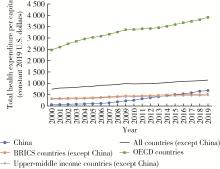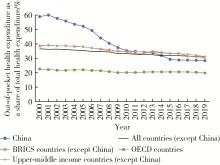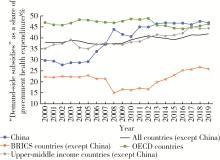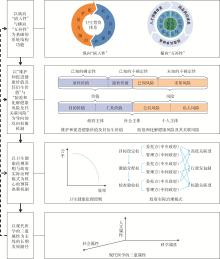北京大学学报(医学版) ›› 2024, Vol. 56 ›› Issue (3): 462-470. doi: 10.19723/j.issn.1671-167X.2024.03.013
中国卫生筹资转型的主要特征与历史沿革
- 北京大学公共卫生学院卫生政策与管理学系,北京 100191
Main characteristics and historical evolution of China' s health financing transition
- Department of Health Policy and Management, Peking University School of Public Health, Beijing 100191, China
摘要:
目的: 了解中国卫生筹资转型的主要特征及历史沿革。方法: 数据来源于全球卫生支出数据库(Global Health Expenditure Database,GHED)、《中国卫生健康统计年鉴》、《全国卫生健康财务年报》、《中国卫生总费用研究报告》等。采用描述性统计和文献研究法进行分析。结果: 21世纪以来,全球多数国家出现了卫生筹资转型现象,表现为卫生筹资规模扩大和公共筹资责任强化。中国的卫生筹资转型特征十分鲜明:一是卫生筹资规模扩大的速度更快,2000—2019年人均卫生总费用按可比价格水平增长了816.6%,明显快于全球其他国家的平均增长速度(102.1%);二是公共筹资责任强化的力度更大,2000—2019年个人现金卫生支出占卫生总费用的比例下降了30.6个百分点,降幅明显大于全球其他国家的平均水平(5.6个百分点);三是公共筹资中政府卫生支出的流向发生了重要转变,“补需方”占比逐渐提高,并于2011年超过“补供方”,同时,在“补供方”内部“补医院”占比持续增加,明显高于“补基层”和“补公卫”。据此可将中国卫生筹资转型扩展为规模维度、结构维度和流向维度三个维度。运用分析框架,将中国卫生筹资转型大致分为计划经济时期、经济转型时期、“后非典”时期和“新医改”以来4个阶段,并对每个阶段的主要特点和演变逻辑进行了分析。结论: 应从系统结构功能层面提高卫生筹资体系的纵向“嵌入性”和横向“互补性”;更加突出卫生筹资转型对维护隐性价值和防范公共风险的作用,完善价值与风险的双向权衡机制;统筹兼顾卫生筹资转型所涉及的卫生健康伦理原则,优化政府实际治理模式下的预算决策机制;高度重视现代医学发展的全局性和深层次影响,探索中国卫生筹资转型的长期战略和路径选择。
中图分类号:
- R197.1
| 1 | 刘继同, 吴明."健康中国"国家发展战略与卫生财政学研究议题[J].湖南财政经济学院学报,2017,33(5):5-19. |
| 2 |
Fan VY , Savedoff WD .The health financing transition: A conceptual framework and empirical evidence[J].Soc Sci Med,2014,105,112-121.
doi: 10.1016/j.socscimed.2014.01.014 |
| 3 | World Health Organization. Global spending on health: A world in transition[R]. Geneva: World Health Organization, 2019. |
| 4 | World Health Organization. Global expenditure on health: Public spending on the rise?[R]. Geneva: World Health Organization, 2021. |
| 5 | Tandon A , Reddy KS .Redistribution and the health financing transition[J].J Glob Health,2021,11,16002. |
| 6 | 朱坤, 刘尚希, 杨良初.新世纪中国卫生财政支出分析[J].财政科学,2022,(1):5-15. |
| 7 | 顾昕.公共财政转型与政府医疗投入机制的改革[J].社会科学研究,2019,(2):141-149. |
| 8 | 杜创, 朱恒鹏.中国城市医疗卫生体制的演变逻辑[J].中国社会科学,2016,(8):66-89. |
| 9 | 王绍光.学习机制与适应能力: 中国农村合作医疗体制变迁的启示[J].中国社会科学,2008,(6):111-133. |
| 10 | 夏杏珍.农村合作医疗制度的历史考察[J].当代中国史研究,2003,(5):110-118. |
| 11 | 方鹏骞, 董四平, 肖婧婧.中国政府卫生投入的制度变迁与路径选择[J].武汉大学学报(哲学社会科学版),2009,62(2):201-212. |
| 12 | 饶克勤, 尹力, 刘远立.中国居民健康转型、卫生服务需求变化及其对经济、社会发展的影响(之一)[J].中国卫生经济,2000,(9):5-11. |
| 13 | 傅虹桥.新中国的卫生政策变迁与国民健康改善[J].现代哲学,2015,(5):44-50. |
| 14 | 项怀诚.中国财政体制改革六十年[J].中国财政,2009,(19):18-23. |
| 15 | 中国医学科学院医学信息研究所.七十年中国健康发展之路[M].北京: 人民卫生出版社,2019. |
| 16 | 李德成. 合作医疗与赤脚医生研究(1955—1983年)[D]. 浙江大学, 2007. |
| 17 | 韩启德.医学的温度[M].北京: 商务印书馆,2020. |
| 18 | 李玲, 江宇, 陈秋霖.改革开放背景下的我国医改30年[J].中国卫生经济,2008,(2):5-9. |
| 19 | 国家卫生计生委统计信息中心. 2013第五次国家卫生服务调查分析报告[R]. 北京: 中国协和医科大学出版社, 2015. |
| 20 | 昝馨.历史的往复: 1978—1992年的中国公立医院改革[J].中国经济史研究,2020,(2):175-190. |
| 21 | Duckett J .The Chinese State's retreat from health: Policy and the politics of retrenchment[M].London: Routledge,2010. |
| 22 | 卫生部统计信息中心. 中国卫生服务调查研究: 第三次国家卫生服务调查分析报告[R]. 北京: 中国协和医科大学出版社, 2004. |
| 23 | World Health Organization. The world health report 2000. Health systems: Improving performance[R]. Geneva: World Health Organization, 2000. |
| 24 | 俞可平.中国治理变迁30年(1978—2008)[J].吉林大学社会科学学报,2008,(3):5-17. |
| 25 | 周飞舟.分税制十年: 制度及其影响[J].中国社会科学,2006,(6):100-115. |
| 26 | 高培勇.中国财税改革40年: 基本轨迹、基本经验和基本规律[J].社会科学文摘,2018,(11):41-42. |
| 27 | 姚泽麟, 赵皓玥, 卢思佳.医疗领域的暴力维权及其治理——基于2002—2015年媒体报道的内容分析[J].社会建设,2017,4(1):49-63. |
| 28 | 王维刚. 中国医药产业成长特征与机理研究[D]. 同济大学, 2007. |
| 29 | 中华人民共和国卫生部.2010中国卫生统计年鉴[M].北京: 中国协和医科大学出版社,2010. |
| 30 | 崔新, 何翔, 张文红, 等.我国卫生监督体系的历史沿革[J].中国卫生监督杂志,2007,(2):157-160. |
| 31 | 孙晓杰.中国卫生服务调查研究[M].北京: 中国协和医科大学出版社,2009. |
| 32 | 顾昕.公共财政转型与政府卫生筹资责任的回归[J].中国社会科学,2010,(2):103-120. |
| 33 | 工业和信息化部. 中国医药统计年报2010[DB/OL]. [2023-11-26]. https://data.cnki.net/yearBook/single?id=N2013020 100. |
| 34 | 国家卫生计生委统计信息中心.2018年全国第六次卫生服务统计调查报告[M].北京: 人民卫生出版社,2021. |
| 35 | 吴俊, 叶冬青.新中国公共卫生实践辉煌70年[J].中华疾病控制杂志,2019,23(10):1176-1180. |
| 36 | 国家统计局工业统计司.2020中国工业统计年鉴[M].北京: 中国统计出版社,2020. |
| 37 | 韩启德.着眼基本医疗促进全民健康[J].医学与哲学(人文社会医学版),2009,30(8):1-3. |
| 38 | 张毓辉.中国卫生筹资公平性现状与挑战[J].卫生经济研究,2013,(8):3-8. |
| 39 | Zhang L , Cheng G , Song S , et al.Efficiency performance of China's health care delivery system[J].Int J Health Plann Ma-nage,2017,32(3):254-263. |
| 40 | 王清波, 胡佳, 代涛.建立分级诊疗制度的动力与阻力分析——基于利益相关者理论[J].中国卫生政策研究,2016,9(4):9-15. |
| 41 | 韩启德.医学是什么[J].民主与科学,2017,(4):4-9. |
| [1] | 靖婷,江华,李婷,申倩倩,叶兰,曾银丹,梁文欣,冯罡,司徒文佑,张玉梅. 中国西部5城市中老年人血清25羟基维生素D与握力的相关性[J]. 北京大学学报(医学版), 2024, 56(3): 448-455. |
| [2] | 闫晓晋,刘云飞,马宁,党佳佳,张京舒,钟盼亮,胡佩瑾,宋逸,马军. 《中国儿童发展纲要(2011-2020年)》实施期间中小学生营养不良率变化及其政策效应分析[J]. 北京大学学报(医学版), 2023, 55(4): 593-599. |
| [3] | 王婷,李乔晟,刘皓冉,简伟研. 人格特征、城乡差异与抑郁症状变化的关系[J]. 北京大学学报(医学版), 2023, 55(3): 385-391. |
| [4] | 邓佳慧,黄筱琳,刘晓星,孙杰,陆林. 中国睡眠医学的过去、现在和未来[J]. 北京大学学报(医学版), 2023, 55(3): 567-封三. |
| [5] | 曹瑞洁,姚中强,焦朋清,崔立刚. 不同分类标准对中国大动脉炎的诊断效能比较[J]. 北京大学学报(医学版), 2022, 54(6): 1128-1133. |
| [6] | 梁喆,范芳芳,张岩,秦献辉,李建平,霍勇. 中国高血压人群中H型高血压的比率和特征及与美国人群的比较[J]. 北京大学学报(医学版), 2022, 54(5): 1028-1037. |
| [7] | 陆林,刘晓星,袁凯. 中国脑科学计划进展[J]. 北京大学学报(医学版), 2022, 54(5): 791-795. |
| [8] | 方伟岗,田新霞,解云涛. 基因多态性对中国汉族女性乳腺癌遗传易感性的影响[J]. 北京大学学报(医学版), 2022, 54(5): 822-828. |
| [9] | 刘小璇,段晓慧,张朔,孙阿萍,张英爽,樊东升. 中国人群遗传性周围神经病的致病基因分布[J]. 北京大学学报(医学版), 2022, 54(5): 874-883. |
| [10] | 张力,龚继芳,潘宏铭,白玉贤,刘天舒,程颖,陈亚池,黄佳莹,许婷婷,葛飞娇,许婉玲,施佳,胡夕春,沈琳. 阿替利珠单抗治疗中国晚期实体瘤患者的开放标签Ⅰ期临床试验[J]. 北京大学学报(医学版), 2022, 54(5): 971-980. |
| [11] | 许颖,次仁央金. 高原红细胞增多症与消化性溃疡出血的关系[J]. 北京大学学报(医学版), 2022, 54(1): 161-165. |
| [12] | 敖英芳. 我国运动医学发展与北京冬奥会和健康中国建设[J]. 北京大学学报(医学版), 2021, 53(5): 823-827. |
| [13] | 郭应禄. 夯实人才培养,实现我国泌尿外科奋斗目标[J]. 北京大学学报(医学版), 2021, 53(4): 633-634. |
| [14] | 周吴平,穆楠,简伟研,王化虹. 克罗恩病患者疾病经济负担现状与相关因素[J]. 北京大学学报(医学版), 2021, 53(3): 555-559. |
| [15] | 王志成,郭岩. 中国社区社会经济地位和成人自评健康的关联研究[J]. 北京大学学报(医学版), 2021, 53(2): 314-319. |
|
||









